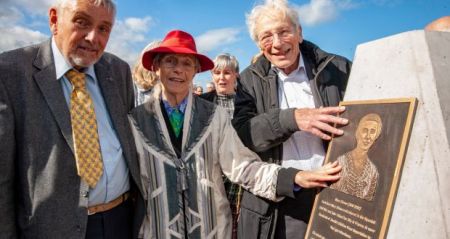
Residents of the War Resisters’ International home in the French Pyrenees at Prats-de-Mollo, housing refugees from the Spanish Civil War
I’ve just finished editing and publishing the Win Happy podcast episode that I recorded with Clodagh Finn, author of “A time to risk all” and Deirdre Waldron, former president of Network Ireland, about the incredible life of the very much unknown Cork woman, Mary Elmes.
(Note: In 2016, having heard about Mary through the Monsignor Hugh O’Flaherty Memorial Committee work, Deirdre in her role as President chose Mary Elmes for the Trish Murphy, Network Ireland Award, the first time it was given posthumously and the first time she was acknowledged in Ireland)
As I was listening to the podcast I was very close to tears when I heard Clodagh describe that moment when one of the children, Charlotte Berger-Greneche saved by Mary Elmes, saw a picture of her mother for the first time when she was 80 years of age.
Clodagh who is incredibly knowledgeable and clearly passionate about Mary Elmes, brings her story to life in the episode and I feel in some ways listening to her, that the spirit of Mary has changed her.
We were privileged to meet two of these children, Charlotte Berger-Greneche and Georges Koltei (pictured above with Mary’s son Patrick Danjou (on the left of the image)) who were saved by Mary from prison camps in France during World War 2.
They were in Cork city recently for the opening of the new bridge that was named in her honour.
Mary Elmes saved 432 children during the Spanish Civil War and World War 2.
Article by Eoin English, Irish Examiner
Article by Barry Roche, Irish Times
There was a beautiful and very poignant quote by her son, Patrick during the bridge opening:
“I think it’s better to have a bridge than a wall, like some friends of ours in America want to do”
Until very recently this story was one that very few people knew, including Mary’s own family – humble people do what they need to do in a huge time of need and then quietly go about their lives after.
Note: Paddy Butler has also written a book about Mary Elmes “The Extraordinary life of Mary Elmes: The Irish Oskar Schindler”
About Mary
Mary Elmes was born on 5 May 1908 in Cork, Ireland to chemist Edward Elmes and Elizabeth Waters. Edward ran a pharmacy on Winthrop Street. The Elmes family went on to be a very prominent one in the business landscape of the city (The building where MacDonalds is located was an Elmes property).
She attended Rochelle School in Cork and in 1928 enrolled at Trinity College Dublin where she was elected a Scholar, and gained a first in Modern Literature (French and Spanish).
As a result of her academic achievements, she was awarded a scholarship in International Studies to study at London School of Economics and then a further scholarship in Geneva, Switzerland.
In 1937, she joined the University of London Ambulance Unit and was sent to a children’s hospital in Almeria in then war-torn Spain. She worked in hospitals as an administrator and carer and also helped in homes looking after children (see picture above). She then moved to France during World War 2.
When it became clear that Jewish children were not legally allowed to be exempt from being sent to the concentration camps, as they had been, Mary, with the help from some colleagues, started to rescue children, taking them to safe houses or helping them flee the country altogether.
Stop for a moment – Can you imagine as a parent, making a decision to hand your children over to someone else, in the full knowledge that you would never see them again and this was the only chance of them having a life?
It is a chilling and heartbreaking thought.
Well aware that she was putting herself at risk, she rescued many children by hiding them in the boot of her car and drove them to safe destinations and aided many others by securing documents, which allowed for them to escape through the undercover network in Vichy France.
While she was not a Quaker herself, she worked actively with local Quaker organisations and was often described as the “head of the Quaker delegation at Perpignan,”.
In 1943, Mary was arrested and was imprisoned in Toulouse and later was moved to the notorious Fresnes Prison run by the Gestapo near Paris, where she spent six months. She was never charged, but when she was released she continued her work with children in prison camps.
Note: In the podcast listen to Clodagh talking about an old blanket that Mary Elmes kept from that prison.
After the war she married and had two children, and lived in Pyrénées-Orientales (Northern Catalonia),
She became the first Irish person to be named Righteous Among the Nations during a ceremony at Israel’s official memorial to Jewish victims of the Holocaust.
Note: Despite gathering the requisite proof that he saved Jews we have been unable to achieve this honour for Monsignor Hugh O’Flaherty.
She passed away in 2002, one month before her 93rd birthday.
If you have the time you might click here to listen to the podcast, maybe read Clodagh’s or Paddy’s excellent books and even better, walk across the beautiful bridge in Cork and think about the bravery of a very special woman, Mary Elmes.
Bridges are better than walls…
Greg



